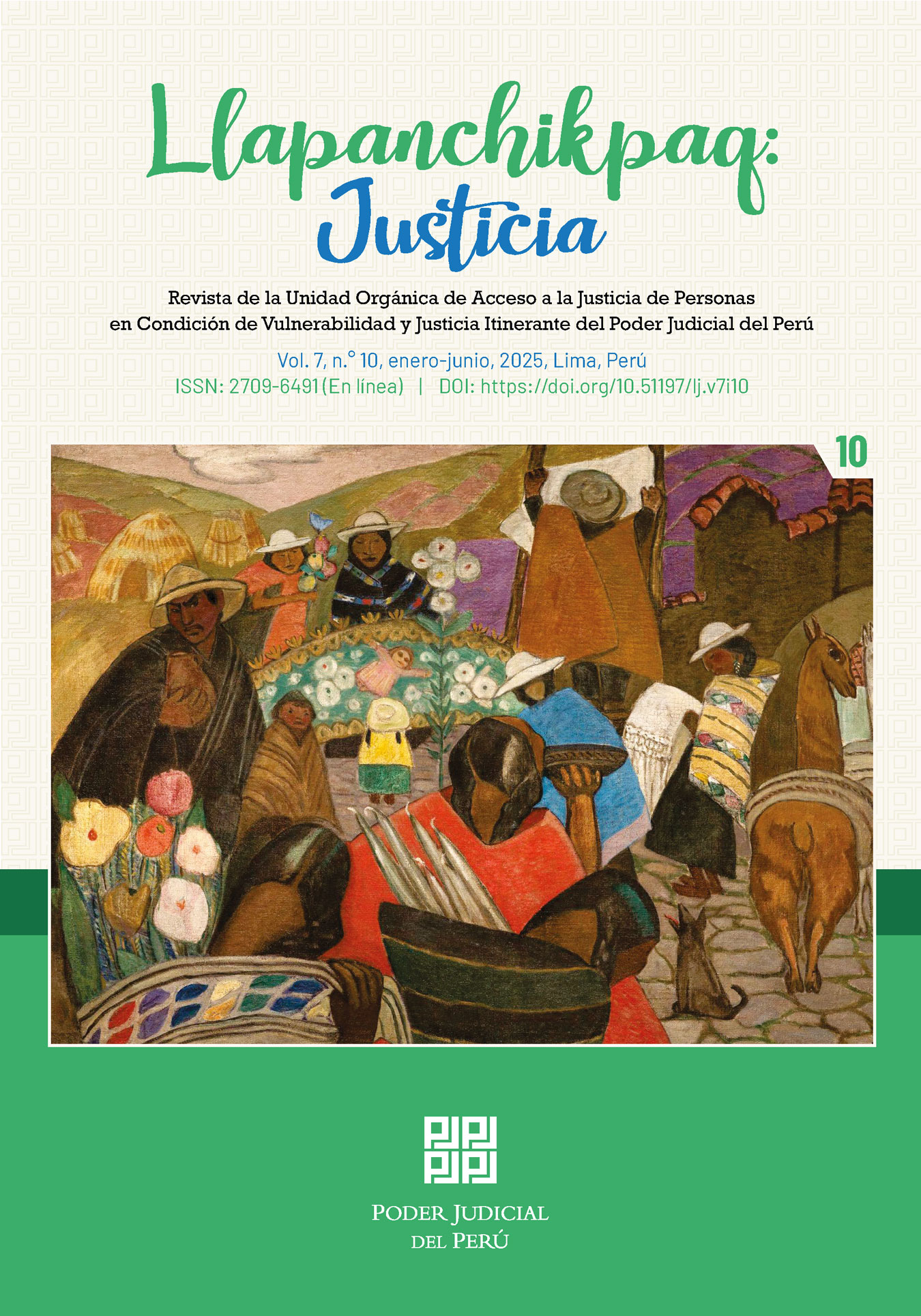The Accessory Prosecutor in Sexual, Domestic, and Gender-Based Violence Offenses
Abstract
This paper aims to demonstrate the suitability of incorporating the figure of the accessory prosecutor into Peru’s accusatory criminal procedure system in cases involving victims of sexual, domestic, and gender-based violence. This proposal is grounded in the need to provide an adequate and timely solution to the numerous cases of the aforementioned types of violence, ensuring the effective and reasonable involvement of the victim in the proceedings. The methods used to support this argument include legal dogmatic analysis and comparative law. The feasibility of this procedural figure within the Peruvian criminal procedure framework is examined through various key aspects. The analysis begins with the role of victims under both the former Code of Criminal Procedure and the current criminal process, to understand the evolution of their treatment throughout history. It also explores the development of victimology as a discipline that, among other things, advocates for better treatment of victims within criminal proceedings.
Furthermore, the paper delves into the study of victims’ rights, highlighting access to justice, to due process, to truth, to full reparation of damages, and to equality of arms as an expression of equality before the law. The legal treatment of the accessory prosecutor is addressed, focusing on its definition, the rights it entails, its limitations, and its distinction from civil parties. Additionally, the figure is analyzed through the lens of comparative legislation (accessory prosecutor, private complainant, private prosecutor, etc.), showing its viability under the Brasilia Rules on access to justice for people in vulnerable situations. Lastly, a compatibility assessment between the accessory prosecutor and the accusatory principle is conducted, concluding that the implementation of the former does not violate the essence of the latter. The paper concludes by establishing the feasibility of incorporating this figure into Peruvian legislation for cases involving victims of sexual, domestic, and gender-based violence.
Downloads
Metrics
References
Bernales Rojas, G. y Dias Mendes, L. (20 de enero de 2022). Los Derechos Fundamentales de la Víctima en el Proceso Penal. Revista Internacional Consinter de direito. https://revistaconsinter.com/index.php/ojs/1410
Bovino, A. (2006). El querellante en los delitos de acción pública en algunos códigos lati-noamericanos. Pensamiento Penal del Sur.
Cancado, A. (2012). El derecho de acceso a la justicia en su amplia dimensión. Edito-rial Librotecnia.
Caro Coria, D. C. y Reyna Alfaro, L. (2023). Derecho penal parte general. Escuela de Derecho LP.
Chana Garrido, F., López Peso, B. y Vilas Pérez, R. (2002). La victimización se-cundaria en los menores testigos de violencia doméstica. Cuadernos de política criminal.
Cubas Villanueva, V. (2005). Principios del Proceso Penal en el Nuevo Código Procesal Penal. Derecho & Sociedad, 157-162.
García Cavero, P. (2012). Derecho Penal-Parte General. Jurista Editores.
García Ramírez, S. (2019). Objeto y fines del proceso penal. Reforma Judicial. Revista Mexicana de Justicia, 1(31-32), 31-54. https://doi.org/10.22201/iij.24487929e.2018.31-32.13290
García-Pablos de Molina, A. (2007). Manual de criminología. introducción y teorías de la criminalidad (6.a ed.). CEC - INPECCP.
García-Pablos de Molina, A. (2009). Los retos de la moderna criminología empírica. En García-Pablos de Molina, A. Constitución, derechos fundamentales y sistema penal. Libro Homenaje al Prof. Tomás Vives Antón (p. 693 y ss). Tirant lo Blanch.
Gómez Colomer, J. (2014). Estatuto jurídico de la víctima del delito. La posición jurí-dica de la víctima del delito ante la justicia penal. Un análisis basado en el derecho compa-rado y en las grandes reformas españolas que se avecinan. Thomson Reuters Aranzadi.
Maier, J. (2003). Derecho Procesal Penal (Vol. II). Editores del Puerto.
Muñoz Conde, F. y Hassemer, W. (2001). Introducción a la Criminología. Tirant lo Blanch.
Nieva Fenoll, J. (2019). Derecho Procesal III Proceso Penal. Tirant lo Blanch.
Obando Peralta, E. (2024). Métodos de investigación jurídica: Análisis de su diversidad y fundamentos epistemológicos. Cuestiones Políticas, 42(81), 18. https://zenodo.org/records/14927514
Poroj Subuyuj, O. (2002). Polémica sobre la oportunidad para constituirse en querellante adhesivo y las exigencias para permanecer como tal. Revista del De-fensor, 10-14. Instituto de Defensa Pública Penal de Guatemala.
Rawls, J. (1995). La Teoría de la Justicia. Fondo Cultura Económica.
Roxin, C. (2019). Derecho Procesal Penal. Didot.
Salas Beteta, C. (2011-II). La eficacia del proceso penal acusatorio en el Perú. Revista Prolegómenos – Derechos y Valores, 263-275.
Sampedro-Arrubla, J. (2008). Los derechos humanos de la víctima: apuntes para la reformulación del sistema penal. Departamento de Derecho Procesal y del Centro de Estudios en Criminología y Victimología «Jorge Enrique Gutiérrez Anzola». Corte Interamericana de Derechos Humanos. https://www.corteidh.or.cr/tablas/R22681.pdf
San Martín Castro, C. (2017). Delito y proceso penal. Gaceta Jurídica.
San Martín Castro, C. (2024). Derecho Procesal Penal: Lecciones (3.ª ed., Vol. I). INPECCP & CENALES.
Schafer, S. (1968). The Victim and his Criminal. A Study in functional responsability. Random House.
Tantaléan Odar, R. (2016). Tipologías de las investigaciones jurídicas. Derecho y Cambio Social(43), 37.
Volk, K., Ambos, K., Planchadell Gargallo, A., Beltrán Montoliu, A. y Madrid Boquín, C. (2023). Derecho procesal penal, alemán y español. Universitat Jaume I.
Copyright (c) 2025 Nerio Alfonso Rojas Cotrina

This work is licensed under a Creative Commons Attribution 4.0 International License.
The authors retain their copyrights and register under the Creative Commons Attribution 4.0 International License (CC BY 4.0), which allows the use of the published material (adapt - remix, transform and build - and share - copy and redistribute - the material in any medium or format).
a. The journal allows authors to retain their copyright of submitted articles without any restrictions.
b. Authors retain the right to share, distribute, copy, perform and publicly communicate the article published in Llapanchipaq Justicia (e.g., place it in an institutional repository).
c. Authors retain the right to make a subsequent publication of their work, to use the article or any part of it (for example: a compilation of their work, notes for conferences, thesis, or for a book), as long as they indicate the source of publication (authors of the work, journal, volume, number and date).
















